new web: http://bdml.stanford.edu/pmwiki
TWiki > Haptics Web>NSFSkinStretchingIdeas? >PerceptionTesting (14 Jul 2008, MarkCutkosky)
Haptics Web>NSFSkinStretchingIdeas? >PerceptionTesting (14 Jul 2008, MarkCutkosky)
New Tests
- DetectionThreshold
- MagnitudeEstimation?
- DifferenceThreshold?
Purpose
Applying skin stretch to non-glabrous skin to provide haptic feedback is relatively new and unexplored area of research. Though fingertip skin stretch displays have been studied, it's unclear how people respond and react to skin stretch on various parts of their body, both qualitatively and quantitatively. In order to begin to test skin stretch as a method of tactile feedback, it's necessary to know a few basic perceptual characteristics to understand the optimal method to apply stretch. These preliminary experiments were completed to determine the difference thresholds of applying rotational skin stretch in shear. How much do we have to change the amount of skin stretch in order for a test subject to feel the difference? We tested two modes of control- first, controlling the amount of skin stretched in terms of position (degrees of rotation) and second, controlling the torque applied to induce skin stretch.Hardware
The device that is being used to apply rotational skin stretch on various parts of the body. The device, shown below, allows us to vary the contact method and test different end-effector configurations to evaluate perception and ability to induce skin stretch. As indicated in the figure, the device has four manually adjustable degrees of freedom to accommodate different sizes of arms and legs while keeping the stretch applicator and the axis of rotation perpendicular to the local skin surface. A low-friction servo motor applies torques to the rotating shaft and the stretch applicator disk, inducing skin stretch primarily in shear. In it's current state, a six-axis force/torque sensor (ATI Nano 17) is mounted between the shaft and the stretch applicator to measure the overall forces and torques applied, however for these preliminary perception experiments, the force sensor was not attached. Only a single axis load cell to estimate the normal force applied to the subject was used.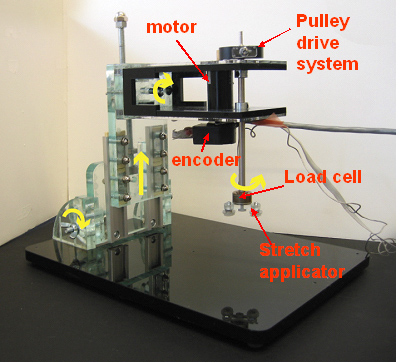
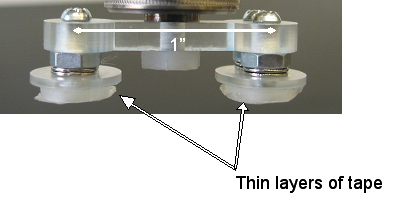 The skin stretch tactor is attached to the test subjects using a skin safe adhesive, True Tape (TM). This tape was the best method of attaching the device to the skin without resorting to using glues or more permanent adhesives. The tactor itself is simply two oval shaped contact points with surface area of 3.5 cm^2 (approx.). An encoder attached to the motor measures rotational changes and is used in a PID feedback control loop to control the number of degrees of skin stretch. To control the torque applied, an open loop, current control was used. The LMD18200 H-Bridge module was used to regulate and measure motor current to estimate the torques applied.
The skin stretch tactor is attached to the test subjects using a skin safe adhesive, True Tape (TM). This tape was the best method of attaching the device to the skin without resorting to using glues or more permanent adhesives. The tactor itself is simply two oval shaped contact points with surface area of 3.5 cm^2 (approx.). An encoder attached to the motor measures rotational changes and is used in a PID feedback control loop to control the number of degrees of skin stretch. To control the torque applied, an open loop, current control was used. The LMD18200 H-Bridge module was used to regulate and measure motor current to estimate the torques applied.
Method
Testing Difference Thresholds
The first set of experiments were conducted to get an estimate of the resolution of skin stretch perception. Two different measures of resolution were obtained- one where the amount of skin stretch was position dependent, and the other where amount of skin stretch was torque dependent. Because there is large subject to subject variation, we were interested in determining of one method of control was better than the other. Difference Thresholds are defined as the following: The minimum difference necessary to distinguish between two signalsMethod of Limits
To obtain these thresholds, we used the Method of Limits [2] The method can be summarized as follows: Present 2 stimuli; a reference and comparison stimulus. Observers report whether the comparison stimulus is greater or less or equal to reference. Increment/decrement comparison stimulus accordingly. In each trial, the comparison stimulus begins at a stimulus that is obviously larger/smaller than the reference stimulus. The comparison stimulus is then decremented/incremented at a fixed step size until the subject finally reports the stimulus perception has changed. For details on this method, see [2]. [2] Gescheider, G.A., "Psychophysics: The Fundamentals." 3rd ed: Lawrence Erlbaum Associates,1997.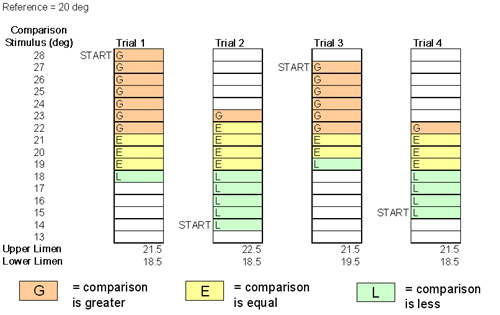 The above image is an example of a typical data set.
To determine the difference threshold for each trial, an upper and lower limen is measured (upper and lower limit where difference in stimulus can be detected). Then it is calculated as follows:
The above image is an example of a typical data set.
To determine the difference threshold for each trial, an upper and lower limen is measured (upper and lower limit where difference in stimulus can be detected). Then it is calculated as follows:
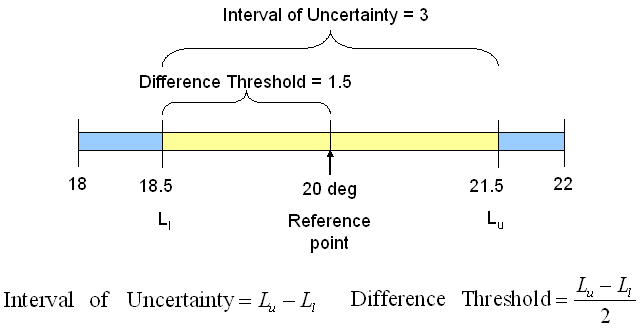 The difference thresholds for each trial are calculated for each subject.
The difference thresholds for each trial are calculated for each subject.
Preliminary results
Position control
In our initial testing, because a detection threshold is unknown, a reference stimulus of 20 degrees was chosen. 20 degrees was chosen because it was a stimulus that could be detected 100% of the time, yet was not near the maximum perceptual magnitude. Other degrees of rotation considered were 10 degrees (too close to the detection threshold limit) and 30 degrees (close to the maximum amount of user-friendly stretch). The skin stretch was tested on the back of the hand. This location was chosen due to the high number of receptors and because there tended to be less hair on test subject's skin in this area than other glaborous skin locations. It is much more difficult to stretch skin on hairy skin due to slipping.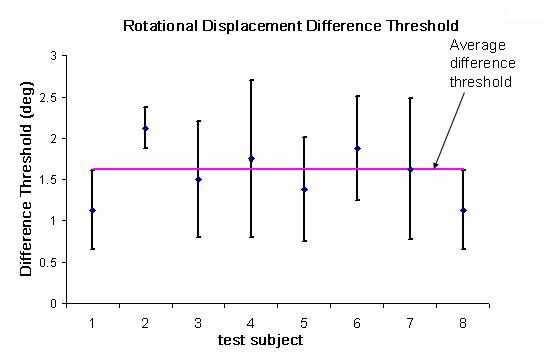 A plot of the difference threshold for each of the 8 subjects tested are shown above. The thresholds varied from 1 to 3 degrees, some subjects had more variation than others.
A plot of the difference threshold for each of the 8 subjects tested are shown above. The thresholds varied from 1 to 3 degrees, some subjects had more variation than others.
Torque Control
Ideas, requests, problems regarding TWiki? Send feedback